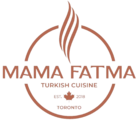Rice is one of the most essential staples in Turkish cuisine, present at almost every meal in a variety of delicious forms. From buttery pilafs to sweet puddings, rice brings warmth, flavor, and texture to the Turkish table. For many families, no lunch or dinner feels complete without a bowl of fragrant, perfectly cooked rice. At Mama Fatma, our locations in Toronto / Ontario / Canada proudly serve traditional Turkish rice dishes that reflect the depth and versatility of this beloved ingredient.
Let’s dive into how rice is used, celebrated, and elevated in Turkish cuisine, and why it’s an ingredient you should pay more attention to—whether you’re cooking at home or dining with us.
Craving the taste of Turkish rice dishes? Visit Mama Fatma and experience flavors that feel like home.
Blog Contents
ToggleTypes Of Rice Used In Turkish Cuisine
Turkish cuisine primarily uses two types of rice: short-grain rice and long-grain rice, each selected based on the dish being prepared.
Baldo rice: A short-grain rice known for its ability to absorb flavors. It’s often used in pilafs and dolma (stuffed vegetables).
Basmati rice: Though not traditionally Turkish, this long-grain rice is sometimes used for lighter dishes or modern adaptations.
Jasmine or Calrose rice: Occasionally used for desserts due to their fragrant or sticky nature.
The rice is typically rinsed thoroughly to remove excess starch, resulting in fluffier, separate grains—a signature trait of a well-made Turkish pilaf.
At Mama Fatma, we use high-quality Baldo rice to ensure our pilafs are both authentic and flavorful.
Turkish-Style Pilaf Basics
Rice pilaf, or pilav, is a cornerstone of Turkish cuisine. It’s a dish that ranges from simple and comforting to rich and festive. What sets Turkish pilaf apart is the technique: rice is lightly toasted in oil or butter before being simmered with water or broth.
Some traditional additions include:
A handful of orzo or vermicelli pasta sautéed until golden
Chicken or lamb broth for deeper flavor
A pinch of salt, black pepper, or allspice
This basic method results in a fluffy, aromatic side dish that pairs well with everything from kebabs to vegetable stews.
Want to master Turkish pilaf at home? Ask our servers for tips after your meal at Mama Fatma!
Adding Vermicelli Or Orzo To Rice
One distinctive touch in Turkish rice preparation is the use of vermicelli or orzo—small pasta shapes that are toasted before rice is added. This adds a subtle nuttiness and a beautiful golden color to the dish.
Rice with vermicelli is one of the most popular versions, commonly served alongside grilled meats.
This method adds depth and interest to otherwise simple rice, making it both a visual and culinary treat.
This technique is particularly appreciated by children and picky eaters who enjoy its comforting, slightly buttery flavor.
Taste our rice with vermicelli and see why this version is a household favorite across Turkey.
Flavored Rice Side Dishes
Turkish cuisine includes many variations of flavored rice, each adapted to complement a specific protein or meal type. Some examples include:
Rice with vegetables: Cooked with peas, carrots, and dill
Rice with currants and pine nuts: Often found in ceremonial meals or stuffed dishes
Meat rice (etli pilav): Made with chunks of seasoned beef or lamb, this is a dish in itself rather than just a side. In English, it’s commonly referred to as rice with meat.
These rice dishes are hearty enough to be enjoyed on their own or can accompany stews and grills beautifully.
Looking for something filling yet familiar? Our rice with meat dish at Mama Fatma is sure to impress.
How Rice Is Served With Kebabs
In Turkish cuisine, rice is the go-to side dish for kebabs. It balances the rich, smoky flavors of grilled meats with its soft texture and mild taste.
Adana kebab and pilaf: The spiciness of Adana-style minced meat is mellowed by plain rice pilaf.
Chicken shish with rice: A lighter pairing that still delivers on satisfaction.
At Mama Fatma, our kebab platters are always accompanied by freshly cooked rice—steamed to perfection and seasoned just right.
Want the perfect pairing? Order any of our kebabs with a side of Turkish pilaf for a complete experience.
Sweet Rice Pudding (Sütlaç)
No exploration of Turkish rice would be complete without mentioning sütlaç, also known as Turkish rice pudding. This beloved dessert is made by slow-cooking rice with sugar and milk, then baking it in the oven for a caramelized top.
Though traditionally made with dairy, vegan versions can substitute plant-based milks like almond or oat, making it accessible to more people.
Its creamy texture and mild sweetness make it a favorite among both children and adults.
Ask our staff if sütlaç is available when you visit Mama Fatma—it’s the perfect ending to any meal.
Rice in Turkish cuisine is more than a side—it’s a symbol of hospitality, warmth, and shared meals. From savory to sweet, every variation holds a special place in Turkish food culture.
Whether you’re savoring a spoonful of şehriyeli pilav or enjoying the rich taste of rice with meat, you’re participating in a tradition that has nourished families for generations.
Discover why rice holds such a cherished place in our kitchen and on our tables—one delicious bite at a time.




